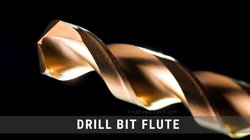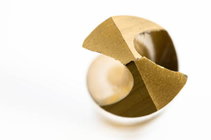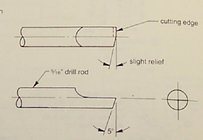It really can’t be that difficult but I cannot get the hole in a light pull down the centre. I’ve kept the drill as short as possible, easing it out to go deeper. And so on… what am I missing?!
-
October 2025 Turning Challenge: Natural Edge Bowl! (click here for details) -
Congratulations to Curt Fuller for "Bell Ornaments" being selected as Turning of the Week for October 27, 2025 (click here for details) -
Welcome new registering member. Your username must be your real First and Last name (for example: John Doe). "Screen names" and "handles" are not allowed and your registration will be deleted if you don't use your real name. Also, do not use all caps nor all lower case.
You are using an out of date browser. It may not display this or other websites correctly.
You should upgrade or use an alternative browser.
You should upgrade or use an alternative browser.
Getting the hole in the middle
- Thread starter Michael Beswick
- Start date
1) use a brad-tipped bit. 2) turn the speed up on your lathe or drill-press.
- Joined
- Apr 27, 2004
- Messages
- 9,292
- Likes
- 6,028
- Location
- Lakeland, Florida
- Website
- www.hockenberywoodturning.com
I always drill the holes before turning when I can.
I use a drill press and have clamp for the blank to save the fingers.
However you should be able to get a straight through hole with a hand held drill.
Your hole may go off line but the two ends will be in a straight line - math says it is so.
I have a step drive that fits a 1/8” hole and a cone on the tail center.
You can drive the piece with an 1/8” rod in a piece of wood in chuck.
One option for the rod is drill bit. Drill in to depth and release from the drill chuck. When you want the bit to use put on the chuck and back it out.
I use a drill press and have clamp for the blank to save the fingers.
However you should be able to get a straight through hole with a hand held drill.
Your hole may go off line but the two ends will be in a straight line - math says it is so.
I have a step drive that fits a 1/8” hole and a cone on the tail center.
You can drive the piece with an 1/8” rod in a piece of wood in chuck.
One option for the rod is drill bit. Drill in to depth and release from the drill chuck. When you want the bit to use put on the chuck and back it out.
Last edited:
Tom Gall
TOTW Team
As @hockenbery said - drill the through hole first then do the turning based on the hole. Will always be centered.
I have a 3/8" gun drill. Self-centering and works great. Con is the cost and that you have to hook it up to an air supply. Thread: gun drill sources
- Joined
- Apr 27, 2004
- Messages
- 9,292
- Likes
- 6,028
- Location
- Lakeland, Florida
- Website
- www.hockenberywoodturning.com
I have a 3/8" gun drill. Self-centering and works great. Con is the cost and that you have to hook it up to an air supply. Thread: gun drill sources
Gun drills work great for bigger holes.
Another con is they aren’t good for small diameter holes.
Lamp pulls and fan pulls want a 1/8” hole to pass the pull chain through.
You can get a 3mm gun drill but I'm guessing it would be very easy to break. A regular bit and pecking at it would be a better choice.Gun drills work great for bigger holes.
Another con is they aren’t good for small diameter holes.
Lamp pulls and fan pulls want a 1/8” hole to pass the pull chain through.
Thanks to everyone. My brain reengaged once You'd described the technique. I think I even have a small jam "chuck" left over from years ago! I only need to make a couple, so gun drills sound fun but are overkill!
I drill on the lathe. Leave the light pull in the headstock chuck and use a Jacobs chuck in the tailstock.
You can use a machinist bit to start a hole


Love these bits. You can find these at McMaster Carr, look for drill point countersink bit. Used in a drill press I've found nothing better for starting a hole in an exact location (in wood). I have a 5/16" with a 1/8" drill point, which are the two most common sizes of hole I drill.
Last edited:
Long ago, someone suggested drilling/boring just a half inch, back out, return and do another 1/2", and so on. That seems to help reduce the wander. Not sure why that would be, but it helps. Drilling and then mounting the tunnel between centers or on a mandrel, is definitely the best way to keep things centered.
- Joined
- Feb 6, 2010
- Messages
- 3,420
- Likes
- 2,502
- Location
- Brandon, MS
- Website
- threeringswoodshop.square.site
Not positive this is the reason but probably the chips probably force the bit to go off course. Pulling out or blowing out chips would either one alleviate the problem.Long ago, someone suggested drilling/boring just a half inch, back out, return and do another 1/2", and so on. That seems to help reduce the wander. Not sure why that would be, but it helps. Drilling and then mounting the tunnel between centers or on a mandrel, is definitely the best way to keep things centered.
Tom Gall
TOTW Team
A lot of good tips & hints about drilling in general above. But c'mon, the OP is talking about a light pull ... probably 2" long max! Back in the last Ice Age when I made light pulls I would drill a short, but slightly larger ∅ hole (3/8" deep or less) to hide the knot or chain coupler ... then drill the through hole for the chain or string. Turn between centers with a 'dead' center (remember those?) or home made mandrel in the headstock and a live center in the tailstock. The hole is automatically centered.
Yup that is the simplest, easiest and mentioned in some of the earliest replies.A lot of good tips & hints about drilling in general above. But c'mon, the OP is talking about a light pull ... probably 2" long max! Back in the last Ice Age when I made light pulls I would drill a short, but slightly larger ∅ hole (3/8" deep or less) to hide the knot or chain coupler ... then drill the through hole for the chain or string. Turn between centers with a 'dead' center (remember those?) or home made mandrel in the headstock and a live center in the tailstock. The hole is automatically centered.
LeoIt is slow going, but this home made D-drill will not wander, but you do need to backout very often to remove the swarf.
View attachment 54457
Any idea why this would wander less than a regular drill?
Mike a regular twist drill is able to flex some and also cut with the flute edge, so it can and will move sideways if the material is not equally hard or solid all around, like we will find in wood, where early and late wood are not equal, also grain is often not in line with the hole to be made.Leo
Any idea why this would wander less than a regular drill?
With a D-drill there is no flute and the body is a solid smooth cylinder that is not able to flex and only cuts on the end of the bit


If you want to see how these D-drill are made and used, here is a link, there are different shapes and uses for D-bits.
D-bit drill
what others have said. 1. drill the hole first and use the hole as a place for a center. 2. use a drill that resists wandering. I use brad point drills a lot. 3. Understand that different densities between summer grain and winter grain can cause a drill bit to wander.It really can’t be that difficult but I cannot get the hole in a light pull down the centre. I’ve kept the drill as short as possible, easing it out to go deeper. And so on… what am I missing?!
I have been making light pulls for about a year. Mostly fish and light houses. What are your steps? I drill the hole first, turn the piece, sand, part off . I put a piece of bamboo skewer into the hole. Mount the stub that sticks out in a variable speed drill with a sewing machine pedal. I paint the piece while it slowly turns. Pull out the skewer and glue in the chain
If you are talking about the old end of the string bobs, sure, drill a through hole. The ones I make are for ceiling fans. About 4 inches long. fish, bobbers, light houses, flip flops, even surf boards for beach houses and lake cabins. I drill a half inch hole and epoxy a 3 inch length of pull chain with one end a half inch into the hole and the other gets a coupling for attachment to the fan. Hardly any one actually pulls on them any way. Most are operated by wall switch or remote control. ,Yup that is the simplest, easiest and mentioned in some of the earliest replies.
The latest edition of Woodturning magazine #386 has an article by Alan Holtham on light pulls.
I took some ceiling fan pulls to my club show and tell about a year ago Everybody thought it was a left field solution to a non-existent problem. At least somebody thinks like me. I am sure they are much nicer than mine.The latest edition of Woodturning magazine #386 has an article by Alan Holtham on light pulls.

Double check that your tailstock and headstock are aligned. Your lathe manufacturer probably has a method to do this. Had this problem and after trying many of the methods suggested in this thread resorted to the alignment check and adjustment. Problem solved. By the way Nova and others offer a tool with MT 2 on both ends of it to facilitate this check and realignment if necessaryIt really can’t be that difficult but I cannot get the hole in a light pull down the centre. I’ve kept the drill as short as possible, easing it out to go deeper. And so on… what am I missing?!
Love the fish Perry! I am guessing that is not a through hole in the fish's mouth, so is it secured with epoxy?
robo hippy
robo hippy
Correct, not a through hole. Drilled a hole a 3/4 inch deep and then used the hole as the center for the tail stock. after turned, I used a scroll saw to cut the mouth of the fish (losing about 1/4 inch of the hole.) and cut the excess off the sides of the tail. that one was with several drops of thick ac glue. I have used epoxy.Love the fish Perry! I am guessing that is not a through hole in the fish's mouth, so is it secured with epoxy?
robo hippy
I have used branches from a dead ash tree and just drilled out the pith 3/4 in deep.
Last edited:

